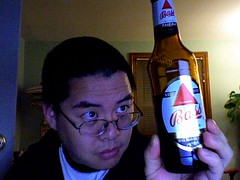I had an epiphany of sorts in the shower.
What a lot of new media folks talk about – audience building, impressions, and the dreaded M word, monetization – is not marketing.
Marketing is the sharing of ideas.
So what is all the stuff we in new media talk about? Sales. Whether it’s pay per click ads, podcast subscriptions, blog readers, speaking gigs, whatever your metric is around getting someone to take action, that’s sales.
Marketing is the sharing of ideas.
Sales is the conversion of ideas into actions.
It’s the job of marketing to share ideas with the audience, to help them to understand what they’re missing out on, what value is awaiting them. It’s all about the content. Content is king, so the cliche goes.
It’s the job of sales to turn those ideas into actions. Create the path for people to take. Make it easy for people to do what you want them to do. Tell them what you want them to do. Click here. Subscribe now. Call the comment line. Leave a comment on the blog. Upload your webmail contacts. That’s all sales – do, do, do.
Once the sale is over, it’s back to marketing, back to sharing. Marketing takes over and reinforces to the audience that the action they took was the right one. Marketing continues to provide value upon value until the customer is so enamored of what you’re doing that they are compelled to share with their friends – and they become your salesforce and marketing team.
Share. Act. Share. Repeat.
This is especially relevant because in many ways, I think we’re reading the wrong books.
Most of my friends in new media are brilliant people. Smart, insightful, good at creating ideas and sharing them. Most of them also wish to be more, do more, achieve more, and this is where the disconnect is. There’s a gap between sharing and acting. Go to any blog and figure out what the action the blogger wants you to take is, and how easy it is to find. Get out your stopwatch, go to any podcaster’s web site, start the clock, and see how long it takes you to subscribe.
Folks like Seth Godin, Chris Anderson, and the marketing folks are perfectly okay. They’re sharing the ideas, and they’re a source for our own inspiration.
Note, however, when you ask any prominent blogger, podcaster, networker, etc. about their bookshelves, they never mention Tom Hopkins, Zig Ziglar, Ira Hayes, Dan Kennedy, Brian Tracy, etc. They never mention the sales books, the sales guys who can help get you from idea to action. Once the customer knows who you are and is willing to make a commitment, you as the new media outlet have to change gears and guide your customer, your audience, into action.
If you want people to do more with your new media outlet, complement your marketing knowledge with sales knowledge, and you’ll blow past the competition in a heartbeat.
Did you enjoy this blog post? If so, please subscribe right now!
Get this and other great articles from the source at www.ChristopherSPenn.com




